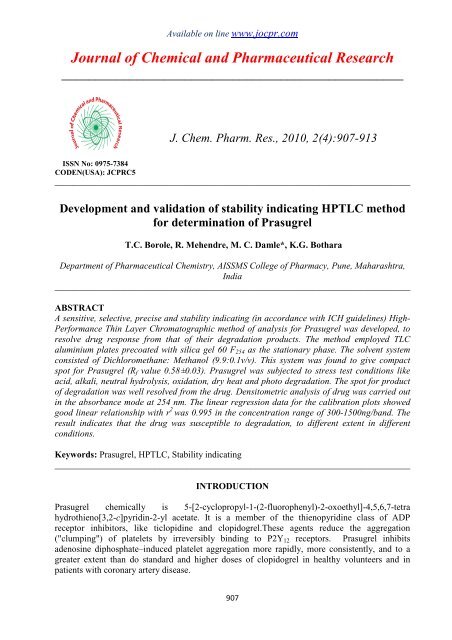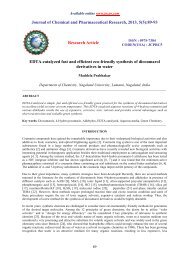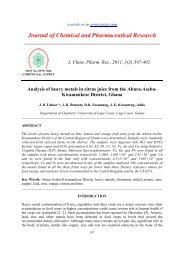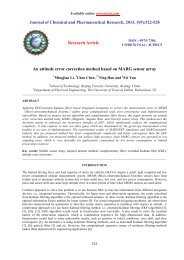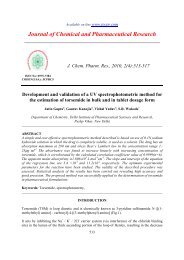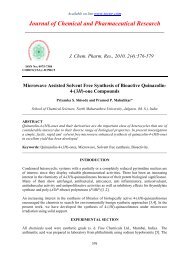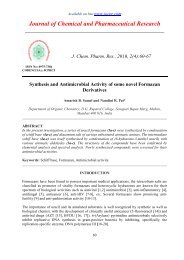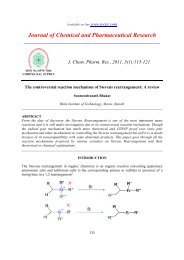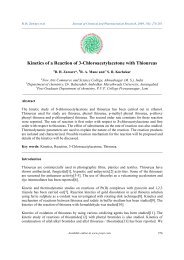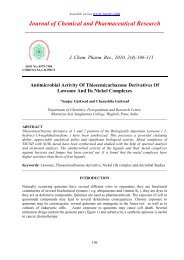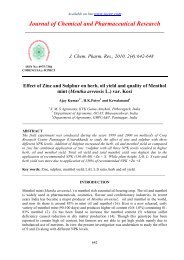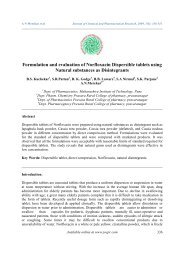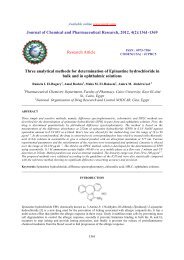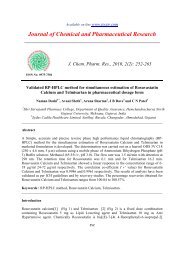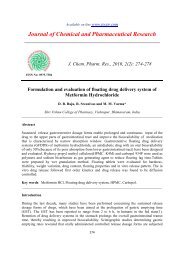Development and validation of stability indicating HPTLC method
Development and validation of stability indicating HPTLC method
Development and validation of stability indicating HPTLC method
You also want an ePaper? Increase the reach of your titles
YUMPU automatically turns print PDFs into web optimized ePapers that Google loves.
Available on line www.jocpr.com<br />
Journal <strong>of</strong> Chemical <strong>and</strong> Pharmaceutical Research<br />
__________________________________________________<br />
J. Chem. Pharm. Res., 2010, 2(4):907-913<br />
ISSN No: 0975-7384<br />
CODEN(USA): JCPRC5<br />
______________________________________________________________________________<br />
<strong>Development</strong> <strong>and</strong> <strong>validation</strong> <strong>of</strong> <strong>stability</strong> <strong>indicating</strong> <strong>HPTLC</strong> <strong>method</strong><br />
for determination <strong>of</strong> Prasugrel<br />
T.C. Borole, R. Mehendre, M. C. Damle*, K.G. Bothara<br />
Department <strong>of</strong> Pharmaceutical Chemistry, AISSMS College <strong>of</strong> Pharmacy, Pune, Maharashtra,<br />
India<br />
______________________________________________________________________________<br />
ABSTRACT<br />
A sensitive, selective, precise <strong>and</strong> <strong>stability</strong> <strong>indicating</strong> (in accordance with ICH guidelines) High-<br />
Performance Thin Layer Chromatographic <strong>method</strong> <strong>of</strong> analysis for Prasugrel was developed, to<br />
resolve drug response from that <strong>of</strong> their degradation products. The <strong>method</strong> employed TLC<br />
aluminium plates precoated with silica gel 60 F 254 as the stationary phase. The solvent system<br />
consisted <strong>of</strong> Dichloromethane: Methanol (9.9:0.1v/v). This system was found to give compact<br />
spot for Prasugrel (R f value 0.58±0.03). Prasugrel was subjected to stres s test conditions like<br />
acid, alkali, neutral hydrolysis, oxidation, dry heat <strong>and</strong> photo degradation. The spot for product<br />
<strong>of</strong> degradation was well resolved from the drug. Densitometric analysis <strong>of</strong> drug was carried out<br />
in the absorbance mode at 254 nm. The linear regression data for the calibration plots showed<br />
good linear relationship with r 2 was 0.995 in the concentration range <strong>of</strong> 300-1500ng/b<strong>and</strong>. The<br />
result indicates that the drug was susceptible to degradation, to different extent in different<br />
conditions.<br />
Keywords: Prasugrel, <strong>HPTLC</strong>, Stability <strong>indicating</strong><br />
______________________________________________________________________________<br />
INTRODUCTION<br />
Prasugrel chemically is 5-[2-cyclopropyl-1-(2-fluorophenyl)-2-oxoethyl]-4,5,6,7-tetra<br />
hydrothieno[3,2-c]pyridin-2-yl acetate. It is a member <strong>of</strong> the thienopyridine class <strong>of</strong> ADP<br />
receptor inhibitors, like ticlopidine <strong>and</strong> clopidogrel.These agents reduce the aggregation<br />
("clumping") <strong>of</strong> platelets by irreversibly binding to P2Y 12 receptors. Prasugrel inhibits<br />
adenosine diphosphate–induced platelet aggregation more rapidly, more consistently, <strong>and</strong> to a<br />
greater extent than do st<strong>and</strong>ard <strong>and</strong> higher doses <strong>of</strong> clopidogrel in healthy volunteers <strong>and</strong> in<br />
patients with coronary artery disease.<br />
907
M. C. Damle et al<br />
J. Chem. Pharm. Res., 2010, 2(4):907-913<br />
_____________________________________________________________________________<br />
Literature survey revealed that some analytical <strong>method</strong>s like LC-MS[1,2] have been reported for<br />
estimation <strong>of</strong> Prasugrel butno <strong>HPTLC</strong> <strong>method</strong> was reported for its analysis. Hence the objective<br />
was to develop a simple, sensitive, accurate <strong>and</strong> precise <strong>method</strong> for determination <strong>of</strong> Prasaugrel.<br />
To the best <strong>of</strong> our knowledge there is no report found for the <strong>stability</strong> <strong>indicating</strong> assay <strong>method</strong> as<br />
per ICH guidelines, for Prasugrel by <strong>HPTLC</strong> <strong>method</strong>. This paper describes a simple, accurate,<br />
sensitive, economic, simple <strong>and</strong> validated <strong>stability</strong> <strong>indicating</strong> <strong>HPTLC</strong> <strong>method</strong> for Prasugrel as<br />
the bulk drug.<br />
The drug <strong>stability</strong> test guidelines[3] Q1A (R2) issued by International Conference on<br />
Harmonization (ICH) requires that analytical test procedures for <strong>stability</strong> samples should be fully<br />
validated <strong>and</strong> the assay should be <strong>stability</strong> <strong>indicating</strong>. The aim <strong>of</strong> the present study accordingly<br />
was to establish inherent <strong>stability</strong> <strong>of</strong> the Prasugrel through stress studies under a variety <strong>of</strong> ICH<br />
recommended test conditions.<br />
EXPERIMENTAL SECTION<br />
Materials<br />
Prasugrel was provided as a gift sample by Alkem Laboratories, Mumbai. Drug was used<br />
without any further purification. All other reagent required for experimentationwas analytical<br />
reagent (AR) grade. Chemicals used for this experiment were Dichloromethane (AR grade),<br />
Methanol (AR grade), NaOH (AR grade), HCl (AR grade), <strong>and</strong> H 2 O 2 (AR grade). These<br />
chemicals were purchased from SD-FINE Chemicals.<br />
Instruments <strong>and</strong> chromatographic conditions<br />
Chromatographic ographic separation <strong>of</strong> drug was performed on TLC plates precoated with silica gel 60<br />
F 254 (10 cm ×10 cm with 250 µm m layer thickness) purchased from E. Merck, Germany. The<br />
sample was applied onto the plate as a b<strong>and</strong> with 4 mm width using Camag 100 µl sample<br />
syringe (Hamilton, Switzerl<strong>and</strong>) with a Linomat 5 applicator (Camag, ag, Switzerl<strong>and</strong>). Linear<br />
ascending development was carried out in a twin trough glass chamber (for 10 x 10 cm).<br />
Densitometric scanning was performed using Camag TLC scanner 3 in the range <strong>of</strong> 200-400 nm<br />
<strong>and</strong> operated by win CATS s<strong>of</strong>tware (V 1.4.3, Camag).<br />
Selection <strong>of</strong> Detection Wavelength<br />
After chromatographic development, b<strong>and</strong>s were scanned over the range <strong>of</strong> 200-400 nm <strong>and</strong> the<br />
spectra were overlain. It was observed that drug showed considerable absorbance at 254 nm. So,<br />
the wavelength <strong>of</strong> detection was 254nm selected.<br />
Method development<br />
Method development, for resolution <strong>of</strong> Prasugrel from its degradation product, was started with<br />
development <strong>of</strong> densitogram with neat solvents <strong>and</strong> combinations <strong>of</strong> Chlor<strong>of</strong>orm, Toluene,<br />
908
M. C. Damle et al J. Chem. Pharm. Res., 2010, 2(4):907-913<br />
_____________________________________________________________________________<br />
Methanol, Acetone, <strong>and</strong> Carbon tetrachloride, Dimethyl Sulfoxide, Dichloromethane <strong>and</strong><br />
Benzene. Finally Dichloromethane: Methanol (9.9:0.1 v/v) was selected as mobile phase with a<br />
good resolution at R f 0.58.<br />
Preparation <strong>of</strong> st<strong>and</strong>ard solution<br />
St<strong>and</strong>ard stock solution <strong>of</strong> Prasugrel was prepared by dissolving 25 mg <strong>of</strong> drug in 25 ml <strong>of</strong><br />
methanolto get concentration <strong>of</strong> 1000µg/ml. The solution was then further diluted with methanol<br />
to get working st<strong>and</strong>ard solutions <strong>of</strong> 100µg/ml.From thissolution a quantity <strong>of</strong> 3,6,9,12 <strong>and</strong> 15<br />
µL was applied on pre-coated silica gel G plate as ab<strong>and</strong> <strong>of</strong> length 4mm at a distance <strong>of</strong> 10mm<br />
from both x-axis<strong>and</strong> y-axis. This plate was developed in developmentchamber using selected<br />
mobile phase.<br />
Stress Degradation studies:<br />
Degradation under acid catalyzed hydrolytic condition<br />
1 ml <strong>of</strong> working st<strong>and</strong>ard solution <strong>of</strong> Prasugrel <strong>of</strong> conc. 1000µg/ml was mixed with 1 ml <strong>of</strong> 0.1<br />
N HCl. The solution was diluted to 10 ml with methanol <strong>and</strong> kept for 4 hours. Appropriate<br />
volume <strong>of</strong> resultant solution (12µL) was applied on TLC plate <strong>and</strong> densitogram was developed.<br />
Degradation under alkali catalysed hydrolytic condition<br />
1 ml <strong>of</strong> working st<strong>and</strong>ard solution <strong>of</strong> Prasugrel <strong>of</strong> each conc. 1000 mcg/ml was mixed with 1ml<br />
<strong>of</strong> 0.01N NaOH. The solutions were diluted to 10 ml with methanol <strong>and</strong> keptit for 5min.<br />
Appropriate volume <strong>of</strong> resultant solution (12µL) was applied on TLC plate <strong>and</strong> densitogram was<br />
developed.<br />
Degradation under neutral hydrolytic condition<br />
5 ml <strong>of</strong> working st<strong>and</strong>ard solutions <strong>of</strong> Prasugrel <strong>of</strong> each conc. 1000 mcg/ml were mixed with 5<br />
ml <strong>of</strong> water. The solutions were diluted to 50 ml with methanol <strong>and</strong> refluxed for 1 hour.<br />
Appropriate volume <strong>of</strong> resultant solution (12µL) was applied on TLC plate <strong>and</strong> densitogram was<br />
developed.<br />
Degradation under oxidative condition<br />
5 ml <strong>of</strong> working st<strong>and</strong>ard solution <strong>of</strong> Prasugrel <strong>of</strong> conc. 1000 mcg/ml was mixed with 5 ml <strong>of</strong><br />
30% H 2 O 2 . The solutions were diluted to 50 ml with methanol <strong>and</strong> refluxed for 1 hour.<br />
Appropriate volume <strong>of</strong> resultant solution (12µL) was applied on TLC plate <strong>and</strong> densitogram was<br />
developed.<br />
Degradation under dry heat<br />
Dry heat studies were performed by keeping drug samples in oven (100 0 C) for a period <strong>of</strong> 6<br />
hours. Samples were withdrawn at appropriate time, dissolved in methanol <strong>and</strong> diluted to get<br />
100mcg/ml as final concentration. Appropriate volume <strong>of</strong> resultant solution (12µL) was applied<br />
on TLC plate <strong>and</strong> densitogram was developed.<br />
Photo-degradation studies<br />
Photolytic studies were also carried out by exposure <strong>of</strong> drug to UV light up to 200 watt<br />
hours/square meter <strong>and</strong> subsequently to cool fluorescent light to achieve an illumination <strong>of</strong> 1.2<br />
million Lux.Hr in photo<strong>stability</strong> chamber (Make : Newtronics). Sample was removed form<br />
chamber, weighed, dissolved <strong>and</strong> diluted get 100mcg/ml as final conc. appropriate volume <strong>of</strong><br />
resultant solution (12µL) was applied on TLC plate <strong>and</strong> densitogram was developed.<br />
Method Validation<br />
The developed <strong>method</strong> was validated as per ICH guidelines[4]<br />
909
M. C. Damle et al J. Chem. Pharm. Res., 2010, 2(4):907-913<br />
_____________________________________________________________________________<br />
Linearity <strong>and</strong> Range<br />
The linearity <strong>of</strong> an analytical procedure is its ability (within a given range) to obtain test results<br />
which are directly proportional to the concentration (amount) <strong>of</strong> analyte in the sample, was<br />
studied by analyzing five concentrations <strong>of</strong> the drug, <strong>and</strong> process was repeated for five times<br />
each. It was done over the range <strong>of</strong> 300-1500ng/b<strong>and</strong>.<br />
Precision<br />
Precision <strong>of</strong> the system was evaluated by analyzing six independent sample preparations<br />
obtained from homogenous sample <strong>and</strong> % RSD value obtained was calculated to determine any<br />
intra-day variation. These studies were also repeated on different days to determine inter-day<br />
variation.<br />
Accuracy<br />
To check accuracy <strong>of</strong> the <strong>method</strong>, recovery studies were carried out by addition <strong>of</strong> st<strong>and</strong>ard drug<br />
solution to pre-analyzed sample solution at three different levels 80, 100 <strong>and</strong> 120 %. Mean<br />
percentage recovery was determined.<br />
Limit <strong>of</strong> detection <strong>and</strong> limit <strong>of</strong> quantitation<br />
The detection limit <strong>of</strong> an individual analytical procedure is the lowest amount <strong>of</strong> analyte in a<br />
sample, which can be detected but not necessarily quantitated as an exact value. Based on the<br />
St<strong>and</strong>ard Deviation <strong>of</strong> the Y-intercept <strong>and</strong> the Slope, detection limit (DL) may be expressed as:<br />
3.3 σ<br />
DL=<br />
S<br />
The quantitation limit <strong>of</strong> an individual analytical procedure is the lowest amount <strong>of</strong> analyte in a<br />
sample, which can be quantitatively determined with suitable precision <strong>and</strong> accuracy. Based on<br />
the St<strong>and</strong>ard Deviation <strong>of</strong> the Response <strong>and</strong> the Slope, The quantitation limit (QL) may be<br />
expressed as:<br />
10 σ<br />
QL=<br />
S<br />
Where,<br />
σ = the st<strong>and</strong>ard deviation <strong>of</strong> the response for the lowest conc. in the range<br />
S = the slope <strong>of</strong> the calibration curve.<br />
Specificity<br />
The specificity <strong>of</strong> the <strong>method</strong> was ascertained by peak purity pr<strong>of</strong>iling studies. Purity <strong>of</strong> the drug<br />
peak was ascertained by analyzing the spectrum at peak start, middle <strong>and</strong> at peak end. The peak<br />
purity was determined on TLC scanner 3 in the range <strong>of</strong> 200-400 nm using WinCats s<strong>of</strong>tware<br />
version 1.4.3.<br />
RESULTS AND DISCUSSION<br />
<strong>Development</strong> <strong>of</strong> the optimum mobile phase<br />
TLC procedure was optimized with a view to develop a <strong>stability</strong>-<strong>indicating</strong> assay <strong>method</strong>. The<br />
drug reference st<strong>and</strong>ard was spotted on the TLC plates <strong>and</strong> developed in different solvent<br />
systems. Different mobile phases were tried to resolve Prasugrel from its degradation product.<br />
Best suited mobile phase were found to be Dichloromethane: Methanol in the ratio <strong>of</strong><br />
910
M. C. Damle et al J. Chem. Pharm. Res., 2010, 2(4):907-913<br />
_____________________________________________________________________________<br />
9.9:0.1(v/v). Developed mobile phase resulted in resolution for Prasugrel with R f 0.58 ± 0.03.<br />
Well-defined spots were obtained when the chamber was saturated with the mobile phase at<br />
room temperature. The representative densitogram is shown in Fig. 1.<br />
Fig.1 Densitogram <strong>of</strong> Prasugrel linearity<br />
Validation <strong>of</strong> the developed <strong>stability</strong>-<strong>indicating</strong> <strong>method</strong>:<br />
Linearity<br />
The data obtained in the linearity experiments was subjected to linear-regression analysis. A<br />
linear relationship between peak areas <strong>and</strong> concentrations was obtained in the range <strong>of</strong> 300-<br />
1500ng /b<strong>and</strong> with r 2 0.995.<br />
Precision<br />
The developed <strong>method</strong> was found to be precise as the % RSD value for repeatability studies was<br />
less than 1%, where as the %RSD for inter-day precision was higher than that <strong>of</strong> repeatability<br />
study.<br />
Accuracy<br />
Excellent recoveries were obtained at each level <strong>of</strong> added concentration. The results obtained (n<br />
= 3 for each 80 %, 100 %, 120 % level) indicated the mean recovery between 98% to 102% for<br />
Prasugrel.<br />
Limit <strong>of</strong> Detection<br />
The limit <strong>of</strong> detection as calculated by st<strong>and</strong>ard formula as given in ICH guidelines was found to<br />
be 286.75ng/b<strong>and</strong> for Prasugrel.<br />
Limit <strong>of</strong> Quantitation<br />
The limit <strong>of</strong> Quantitation as calculated by st<strong>and</strong>ard formula as given in ICH guidelines was<br />
found to be 869ng/b<strong>and</strong> for Prasugrel.<br />
Specificity<br />
The specificity <strong>of</strong> the <strong>method</strong> was ascertained by peak purity pr<strong>of</strong>iling studies. The peak purity<br />
values were found within limit, <strong>indicating</strong> the non interference <strong>of</strong> any other peak <strong>of</strong> degradation<br />
product, impurity or matrix.<br />
911
M. C. Damle et al J. Chem. Pharm. Res., 2010, 2(4):907-913<br />
_____________________________________________________________________________<br />
Degradation pattern observed:<br />
Under alkaline condition 45.84% degradation <strong>of</strong> Prasugrel was observed <strong>and</strong> 1 peak for<br />
degradation product was observed at R f = 0.34(Fig. 2). Spectra <strong>of</strong> degradation product, differs<br />
from that <strong>of</strong> Prasugrel spectra(Fig. 3).<br />
Fig.2: Densitogram <strong>of</strong> Prasugrel after alkaline hydrolysis<br />
Fig. 3: Overlain UV spectra <strong>of</strong> Prasugrel <strong>and</strong> hydrolytic degradation product<br />
Under the acidic condition, 62.43% degradation was found. There is no peak for degradation<br />
product. However, the area for Prasugrel peak was reduced.<br />
In Neutral hydrolysis Prasugrel was not degraded. This indicates <strong>stability</strong> <strong>of</strong> Prasugrel to Neutral<br />
hydrolysis.<br />
In oxidative study, 71.56% degradation was observed. There is no peak for degradation product<br />
After the dry heat treatment 50% degradation <strong>of</strong> Prasugrel occurred. No peaks <strong>of</strong> degradation<br />
were obtained. However, the area for Prasugrel peak was reduced.<br />
Degradation <strong>of</strong> Prasugrel was 22.60% upon exposure to UV light <strong>and</strong> 23.48% upon exposure to<br />
Fluorescent light (after UV light exposure)in photo <strong>stability</strong> chamber.<br />
912
M. C. Damle et al J. Chem. Pharm. Res., 2010, 2(4):907-913<br />
_____________________________________________________________________________<br />
CONCLUSION<br />
Thus Prasugrel appears to be prone to hydrolytic, thermal <strong>and</strong> oxidative degradation <strong>and</strong> should<br />
be protected accordingly. This developed <strong>HPTLC</strong> <strong>method</strong> can be used for <strong>stability</strong> monitoring <strong>of</strong><br />
Prasugrel.<br />
Acknowledgement<br />
The authors are thankful to AlkemLaboratories,Mumbaifor providing a working st<strong>and</strong>ard <strong>of</strong><br />
Prasugrel. The authors are also thankful to the Principal, AISSMS College <strong>of</strong> pharmacy for<br />
providing necessary facilities <strong>and</strong> constant encouragement.<br />
REFERENCES<br />
[1] ER Tian; KJ Ruterbories; EM Verburg; GJ Weerakkody; FN Kurihara.American Society for<br />
Pharmacology <strong>and</strong> Experimental Therapeutics,2007,35(6), 917-921.<br />
[2] NA Farid; M McIntosh; F Gar<strong>of</strong>olo; E Wong; A Shwajch; M Kennedy; M Young; P Sarkar;<br />
K Kawabata; M Takahashi; H Pang. Rapid Communications in Mass Spectrometry,2007, 21(2),<br />
169-179.<br />
[3] ICH, Q1A (R2), Stability Testing <strong>of</strong> New Drug Substances <strong>and</strong> Products, Geneva, Feb.2003.<br />
[4] ICH, Q2 (R1), Validation <strong>of</strong> Analytical Procedures: Text <strong>and</strong> Methodology International<br />
conference on Harmonization, Geneva, 2005, 1-13.<br />
913


